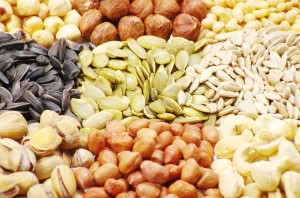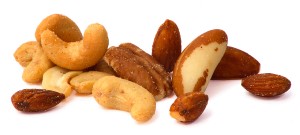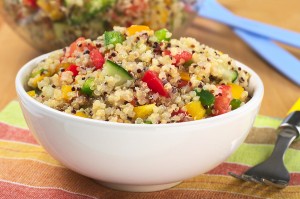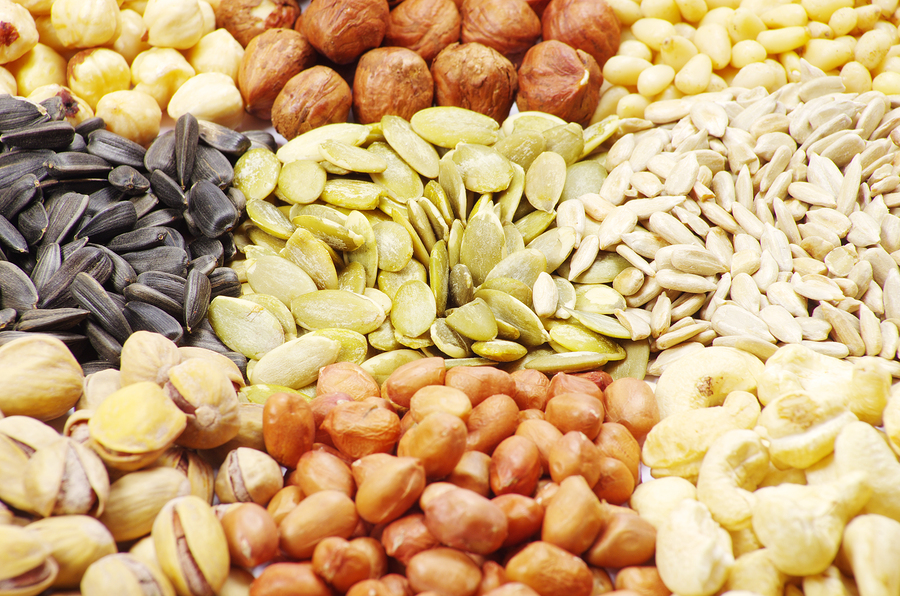
Times have changed from when we used to joke about folks who ate “nuts and berries.” Today’s athletes routinely enjoy nuts and berries and are now looking for ways to notch up their diets with more seeds (such as flax and chia) and whole grains (such as quinoa). This trend can enhance the health of both our bodies and the planet. That is, by choosing more plant foods, we’ll end up eating less meat and animal protein. If each of us were to eat just one less pound of beef per week, greenhouse gas emissions would drop significantly.
While seeds and grains are health-enhancing choices to include in your sports diet, their nutritional value can sometimes get exaggerated. The following information offers a perspective on some “trendy” foods that are getting mainstreamed.
Nuts and Seeds
Want to add a nice crunch, along with vitamins and minerals, to your sports diet? Sprinkle some slivered almonds, chopped walnuts, pistachios, sunflower and sesame seeds into your yogurt, cereal, salad, and smoothie. Nuts and seeds offer protein, healthy fats, fiber, vitamin E, magnesium, and many other nutrients. The fact that a plant grows from a nut or seed indicates it is life sustaining.
Many nuts and seeds offer alpha linoleic acid, also known as ALA, a type of health-protective omega-3 polyunsaturated fat. While ALA from plants is not as potent as the type of omega-3s found in fish, any omega-3 fat is better than none. But dieters beware! When you nonchalantly toss a few spoonfuls of nuts and seeds into your smoothies and salads to pump up their nutritional value, you can also easily toss in 100 to 400 calories. While vegans may need this protein and calorie boost, weight-conscious athletes who consume dairy and animal proteins might want to think twice.
Comparing Seeds and Nuts
This chart shows how 1/4 cup of nuts and seeds (two spoonfuls or a large handful) adds a lot of calories but minimal protein towards the daily target of about 60 to 90 grams of protein. Vegans still need additional plant proteins, like beans and tofu, to get enough protein.
| Seed¼ cup/30 g | Calories | Protein g | Fiber g | Calcium mg | Ironmg |
| Chia | 140 | 5 | 10 | 180 | 8 |
| Flax, ground | 150 | 5 | 8 | 70 | 1.5 |
| Hemp seeds | 180 | 10 | 4 | — | 1 |
| Sunflower | 190 | 6 | 3 | 20 | 1 |
| Pumpkin | 170 | 9 | 2 | 50 | 2 |
| Sesame | 200 | 6 | 4 | 350 | 5 |
| Walnuts | 190 | 4 | 2 | 30 | 1 |
| Daily target: 60-90 g | Daily target: 25-35 g | Daily target:1,000 mg | Daily target:8 mg men 18 women |

Flax seeds, commonly consumed for their ALA omega-3 fat benefits, need to be ground before being eaten. Otherwise, they pass through your intestines whole and undigested.
Chia seeds also offer ALA omega-3 fats—but you don’t need to grind them. Just sprinkle chia on yogurt and enjoy the crunch. When soaked in water for 10 minutes, chia seeds create a gel that can be used as a thickener for smoothies and as an alternative to eggs and oils in some recipes. The slimy consistency of soaked chia seeds can be tough to enjoy for some athletes. If you fall into the “no thank you camp,” worry not. You have many other options for enjoyably consuming similar nutrients in other seeds and nuts.
Sunflower seeds have a mild, pleasing taste when added to salads, trail mix, or cold cereals. For people with peanut allergies, sunflower butter is a popular alternative to peanut butter.
Pumpkin seeds, also known as pepitas, are slower to eat when you buy them in the shell. This can save unwanted calories.
Hemp seeds are touted as containing all the essential amino acids. Hemp adds a protein-boost to vegan diets, but at a high price. Hemp seeds costs about $15 per pound, as compared to soy nuts, that also have all the amino acids, about $3.50/lb.
Sesame seeds have a gentle flavor and make a nice addition to stir-fried tofu or chicken. Although sesame seeds are touted as being calcium-rich, their calcium is poorly absorbed.
Chopped nuts, such as walnuts or slivered almonds, add a protein boost—but not as much of a protein bonus as many athletes think. If you ate half a cup of walnuts (two man-sized handfuls), you’d get only 8 grams of protein. For the same calories, you could add 1.5 cups of cottage cheese to your salad and get five times more protein (40 grams).
Grains

Both whole and refined grain foods offer carbohydrates that easily fuel your muscles. Whole grains include whole wheat, brown rice, corn (including popcorn), oats, barley, millet, and quinoa. Unrefined grains offer trace minerals, such as magnesium and copper, that refined grains don’t offer because they are lost in processing.
However, most refined grains are enriched with B-vitamins and iron, two important nutrients for athletes. So, if you end up eating some white pasta or bread, there’s no need to fret! Dietary guidelines allow for half of the grains you consume to be refined.
Quinoa is actually a seed, but we eat it as a grain, and it offers more protein than other grains. But take note (see the chart below): Quinoa is not a protein powerhouse, so eat it with tofu, beans or yogurt to reach the target of 20 to 30 grams protein per meal. Quinoa is also expensive: $6 per pound, as compared to brown rice at $1.50 per pound.
| Grain/ starch | 1 cup cooked | Calories | Protein g | Fiber g | Ironmg |
| Pasta, white | 2 oz dry | 200 | 7 | 2 | 2 |
| Pasta, whole wheat | 2 oz dry | 200 | 8 | 6 | 2 |
| Rice, white | 1/3 c raw | 225 | 4 | 1 | 2 |
| Rice, brown | 1/3 c raw | 225 | 5 | 2 | 1 |
| Couscous | 1/3 c raw | 215 | 7 | 3 | 1 |
| Quinoa | 1/3 c raw | 200 | 8 | 5 | 3 |
The bottom line:
When you resolve to “eat healthier,” be sure to create a sustainable plan that will offer lifelong enjoyment. While you want to explore new foods, you don’t have to routinely choke down seeds and whole grains that do not really please your taste buds. By filling your meals with a variety of wholesome foods—including generous portions of colorful fruits and vegetables—you’ll be able to consume abundant nutrients that invest in both good health and top performance. Plus, you’ll also help save the planet when you choose more seeds and grains instead of steaks and chops.
Nancy Clark, MS, RD, CSSD (Board Certified Specialist in Sports Dietetics) counsels both casual and competitive athletes at her office in Newton, MA (617-795-1875). Her Sports Nutrition Guidebook and food guides for new runners, marathoners, and soccer players offer additional information. They are available at www.nancyclarkrd.com. See also www.sportsnutritionworkshop.
RECIPE using nuts, seeds, grains, and spices
This Super Spice Trail Mix includes a yummy combination of health-enhancing nuts, seeds, grain, and spices. Pack it into little individual baggies for snacks, sprinkle it into yogurt, or add it to cold or hot cereal. It offers a really nice crunch and flavor boost to shredded wheat and other bland cereals.
I found this recipe at www.McCormick.com. The McCormick Spice website offers lots of really nice and flavorful recipes filled with herbs and spices. Take a tour?
1/4 cup firmly packed brown sugar
2 teaspoons cinnamon
2 teaspoons ginger
2 teaspoons paprika
3 cups nuts, such as a mix of almonds, shelled pistachios, and pecan halves
1 cup rolled oats
1 cup roasted pepitas (shelled pumpkin seeds)
1/4 cup apple juice concentrate, thawed
1-1/2 cups dried fruit, such as a mix of dried cherries, cranberries, and golden raisins
1. Preheat oven to 250°F. Mix brown sugar, cinnamon, ginger and paprika in small bowl. Set aside.
2. Place nuts, oats, and pepitas in a large bowl. Add thawed apple juice concentrate; toss until nuts are evenly coated.
3. Sprinkle with spice mixture, tossing to coat well.
4. Spread evenly on two 15x10x1-inch baking pans. Bake 30 minutes, stirring halfway through cook time. Cool completely on wire rack.
5. Stir in cherries and raisins. Store in airtight container.
Yield: 24 ¼-cup servings
Approximate calories per serving: 200



7 Comments
Comments are closed.